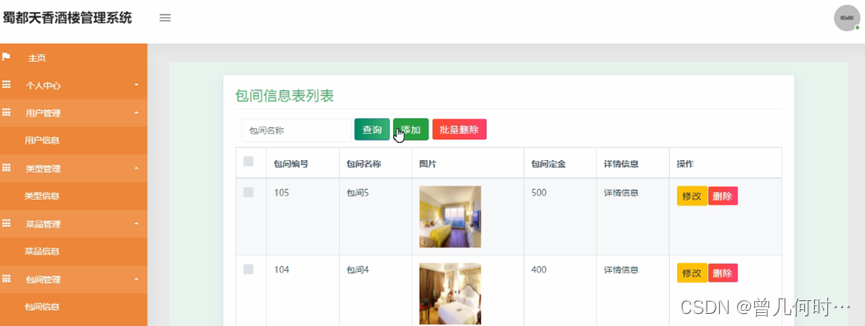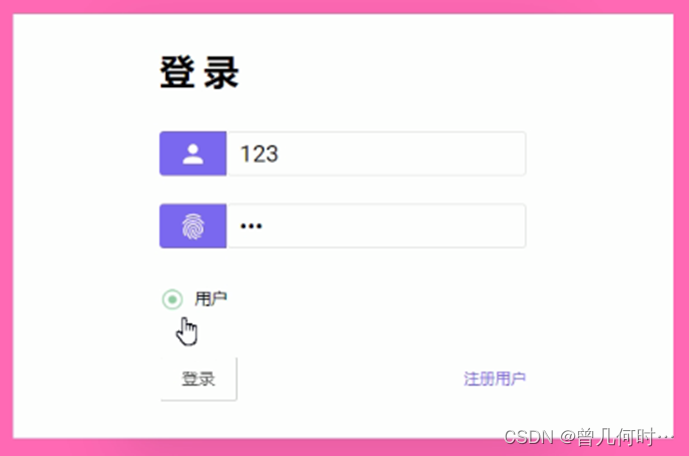末尾获取源码
开发语言:Java
Java开发工具:JDK1.8
后端框架:SSM
前端:采用JSP技术开发
数据库:MySQL5.7和Navicat管理工具结合
服务器:Tomcat8.5
开发软件:IDEA / Eclipse
是否Maven项目:是
目录
一、项目简介
近年来,信息化管理行业的不断兴起,使得人们的日常生活越来越离不开计算机和互联网技术。首先,根据收集到的用户需求分析,对设计系统有一个初步的认识与了解,确定蜀都天香酒楼管理系统的总体功能模块。然后,详细设计系统的主要功能模块,通过数据库设计过程将相关的数据信息存储到数据库中,再通过使用关键的开发工具,如MyEclipse开发平台、JSP技术等,编码设计相关的功能模块。接着,主要采用功能测试的方式对系统进行测试,找出系统在运行过程中存在的问题,以及解决问题的方法,不断地改进和完善系统的设计。最后,总结本文介绍的系统的设计和实现过程,并且针对于系统的开发提出未来的展望工作。本系统的研发具有重大的意义,在安全性方面,用户使用浏览器访问网站时,采用注册和密码等相关的保护措施,提高系统的可靠性,维护用户的个人信息和财产的安全。在方便性方面,促进了酒楼管理行业的信息化建设,极大的方便了相关的工作人员对酒楼信息进行管理。
二、研究背景与意义
信息化管理模式是将行业中的工作流程由人工服务,逐渐转换为使用计算机技术的信息化管理服务。这种管理模式发展迅速,使用起来非常简单容易,用户甚至不用掌握相关的专业知识,根据教程指导即可正常使用相关的系统,因而被越来越多的用户所使用。由于相关行业管理信息化,这就使得管理工作不在受到时间和区域的限制,随时随地即可完成相关的工作任务和结果[1]。就目前而言,管理信息化在现代社会中非常流行,使用比较广泛。早在20世纪70年代末,就出现了早期的电子商务,相关的公司企业使用计算机建立专用的内部网络,通过内部网络完成相应的采购、销售等活动,加快相关的企业之间的交易速度,提高了工作效率[2]。
当下,许多行业采用互联网技术将工作流程信息化、数字化,提高了相关人员的服务质量和效率,节约了相关行业的人力、财力、物力等资源,与此同时,人们获取外界的相关信息主要依赖于主流的信息化技术和工具。人们对生活的需求也在不断的发生着变化,为了应对用户的多样化需求,许多相关的第三产业应运而生,管理信息化也逐渐的流行起来,比如电子商务行业。本人通过查询大量学习资料,了解基本的开发系统的基本背景和关键任务,学习与掌握Java语言、web技术、JSP技术、HTML语言等开发技术,设计系统功能模块,以及MySQL数据库的相关语法和工具,创建和存储数据表格,反映和关联表格之间相互存在的关系,由此对蜀都天香酒楼管理系统进行研发和实现。
三、系统项目截图
3.1管理员功能实现
管理员可以选择任一浏览器打开网址,输入信息无误后,以管理员的身份行使相关的管理权限

管理员可以通过选择用户管理,管理相关的用户信息记录,比如进行用户账号查看,用户名称修改等操作

管理员可以通过选择类型管理,管理相关的类型信息记录,比如进行菜品类型添加,套餐类型查看,饮料类型修改等操作

管理员可以通过选择菜品管理,管理相关的菜品信息记录,比如进行菜品名称查看,详情信息查看,价格修改等操作

管理员通过选择包间管理,管理相关的包间信息记录,比如进行包间名称查看,包间信息查询,包间定金修改等操作

管理员通过选择系统管理,管理相关的系统信息,比如进行客服管理,轮播图管理,活动咨询查看等操作



3.2用户功能实现
用户在浏览器中打开本系统,可以进行活动咨讯查看,包间预定,菜品信息查看等操作

用户可以通过选择包间预定,预定相关的包间信息,比如进行包间详情信息查看,包间预定,包间评价等操作

用户可以通过选择菜品信息,查看相关的菜品信息记录,比如进行菜品名称查看,添加菜品到购物车,立即购买菜品等操作

用户可以通过选择个人中心,管理与个人相关的信息,比如进行个人资料查看,个人订单查看,个人收藏管理等操作

四、核心代码
4.1登录相关
package com.controller;
import java.util.Arrays;
import java.util.Calendar;
import java.util.Date;
import java.util.Map;
import javax.servlet.http.HttpServletRequest;
import org.springframework.beans.factory.annotation.Autowired;
import org.springframework.stereotype.Controller;
import org.springframework.web.bind.annotation.GetMapping;
import org.springframework.web.bind.annotation.PathVariable;
import org.springframework.web.bind.annotation.PostMapping;
import org.springframework.web.bind.annotation.RequestBody;
import org.springframework.web.bind.annotation.RequestMapping;
import org.springframework.web.bind.annotation.RequestParam;
import org.springframework.web.bind.annotation.ResponseBody;
import org.springframework.web.bind.annotation.RestController;
import com.annotation.IgnoreAuth;
import com.baomidou.mybatisplus.mapper.EntityWrapper;
import com.entity.TokenEntity;
import com.entity.UserEntity;
import com.service.TokenService;
import com.service.UserService;
import com.utils.CommonUtil;
import com.utils.MD5Util;
import com.utils.MPUtil;
import com.utils.PageUtils;
import com.utils.R;
import com.utils.ValidatorUtils;
/**
* 登录相关
*/
@RequestMapping("users")
@RestController
public class UserController{
@Autowired
private UserService userService;
@Autowired
private TokenService tokenService;
/**
* 登录
*/
@IgnoreAuth
@PostMapping(value = "/login")
public R login(String username, String password, String captcha, HttpServletRequest request) {
UserEntity user = userService.selectOne(new EntityWrapper<UserEntity>().eq("username", username));
if(user==null || !user.getPassword().equals(password)) {
return R.error("账号或密码不正确");
}
String token = tokenService.generateToken(user.getId(),username, "users", user.getRole());
return R.ok().put("token", token);
}
/**
* 注册
*/
@IgnoreAuth
@PostMapping(value = "/register")
public R register(@RequestBody UserEntity user){
// ValidatorUtils.validateEntity(user);
if(userService.selectOne(new EntityWrapper<UserEntity>().eq("username", user.getUsername())) !=null) {
return R.error("用户已存在");
}
userService.insert(user);
return R.ok();
}
/**
* 退出
*/
@GetMapping(value = "logout")
public R logout(HttpServletRequest request) {
request.getSession().invalidate();
return R.ok("退出成功");
}
/**
* 密码重置
*/
@IgnoreAuth
@RequestMapping(value = "/resetPass")
public R resetPass(String username, HttpServletRequest request){
UserEntity user = userService.selectOne(new EntityWrapper<UserEntity>().eq("username", username));
if(user==null) {
return R.error("账号不存在");
}
user.setPassword("123456");
userService.update(user,null);
return R.ok("密码已重置为:123456");
}
/**
* 列表
*/
@RequestMapping("/page")
public R page(@RequestParam Map<String, Object> params,UserEntity user){
EntityWrapper<UserEntity> ew = new EntityWrapper<UserEntity>();
PageUtils page = userService.queryPage(params, MPUtil.sort(MPUtil.between(MPUtil.allLike(ew, user), params), params));
return R.ok().put("data", page);
}
/**
* 列表
*/
@RequestMapping("/list")
public R list( UserEntity user){
EntityWrapper<UserEntity> ew = new EntityWrapper<UserEntity>();
ew.allEq(MPUtil.allEQMapPre( user, "user"));
return R.ok().put("data", userService.selectListView(ew));
}
/**
* 信息
*/
@RequestMapping("/info/{id}")
public R info(@PathVariable("id") String id){
UserEntity user = userService.selectById(id);
return R.ok().put("data", user);
}
/**
* 获取用户的session用户信息
*/
@RequestMapping("/session")
public R getCurrUser(HttpServletRequest request){
Long id = (Long)request.getSession().getAttribute("userId");
UserEntity user = userService.selectById(id);
return R.ok().put("data", user);
}
/**
* 保存
*/
@PostMapping("/save")
public R save(@RequestBody UserEntity user){
// ValidatorUtils.validateEntity(user);
if(userService.selectOne(new EntityWrapper<UserEntity>().eq("username", user.getUsername())) !=null) {
return R.error("用户已存在");
}
userService.insert(user);
return R.ok();
}
/**
* 修改
*/
@RequestMapping("/update")
public R update(@RequestBody UserEntity user){
// ValidatorUtils.validateEntity(user);
userService.updateById(user);//全部更新
return R.ok();
}
/**
* 删除
*/
@RequestMapping("/delete")
public R delete(@RequestBody Long[] ids){
userService.deleteBatchIds(Arrays.asList(ids));
return R.ok();
}
}
4.2文件上传
package com.controller;
import java.io.File;
import java.io.FileNotFoundException;
import java.io.IOException;
import java.util.Arrays;
import java.util.Date;
import java.util.HashMap;
import java.util.List;
import java.util.Map;
import java.util.Random;
import java.util.UUID;
import org.apache.commons.io.FileUtils;
import org.apache.commons.lang3.StringUtils;
import org.springframework.beans.factory.annotation.Autowired;
import org.springframework.http.HttpHeaders;
import org.springframework.http.HttpStatus;
import org.springframework.http.MediaType;
import org.springframework.http.ResponseEntity;
import org.springframework.util.ResourceUtils;
import org.springframework.web.bind.annotation.PathVariable;
import org.springframework.web.bind.annotation.RequestBody;
import org.springframework.web.bind.annotation.RequestMapping;
import org.springframework.web.bind.annotation.RequestParam;
import org.springframework.web.bind.annotation.RestController;
import org.springframework.web.multipart.MultipartFile;
import com.annotation.IgnoreAuth;
import com.baomidou.mybatisplus.mapper.EntityWrapper;
import com.entity.ConfigEntity;
import com.entity.EIException;
import com.service.ConfigService;
import com.utils.R;
/**
* 上传文件映射表
*/
@RestController
@RequestMapping("file")
@SuppressWarnings({"unchecked","rawtypes"})
public class FileController{
@Autowired
private ConfigService configService;
/**
* 上传文件
*/
@RequestMapping("/upload")
public R upload(@RequestParam("file") MultipartFile file,String type) throws Exception {
if (file.isEmpty()) {
throw new EIException("上传文件不能为空");
}
String fileExt = file.getOriginalFilename().substring(file.getOriginalFilename().lastIndexOf(".")+1);
File path = new File(ResourceUtils.getURL("classpath:static").getPath());
if(!path.exists()) {
path = new File("");
}
File upload = new File(path.getAbsolutePath(),"/upload/");
if(!upload.exists()) {
upload.mkdirs();
}
String fileName = new Date().getTime()+"."+fileExt;
File dest = new File(upload.getAbsolutePath()+"/"+fileName);
file.transferTo(dest);
FileUtils.copyFile(dest, new File("C:\\Users\\Desktop\\jiadian\\springbootl7own\\src\\main\\resources\\static\\upload"+"/"+fileName));
if(StringUtils.isNotBlank(type) && type.equals("1")) {
ConfigEntity configEntity = configService.selectOne(new EntityWrapper<ConfigEntity>().eq("name", "faceFile"));
if(configEntity==null) {
configEntity = new ConfigEntity();
configEntity.setName("faceFile");
configEntity.setValue(fileName);
} else {
configEntity.setValue(fileName);
}
configService.insertOrUpdate(configEntity);
}
return R.ok().put("file", fileName);
}
/**
* 下载文件
*/
@IgnoreAuth
@RequestMapping("/download")
public ResponseEntity<byte[]> download(@RequestParam String fileName) {
try {
File path = new File(ResourceUtils.getURL("classpath:static").getPath());
if(!path.exists()) {
path = new File("");
}
File upload = new File(path.getAbsolutePath(),"/upload/");
if(!upload.exists()) {
upload.mkdirs();
}
File file = new File(upload.getAbsolutePath()+"/"+fileName);
if(file.exists()){
/*if(!fileService.canRead(file, SessionManager.getSessionUser())){
getResponse().sendError(403);
}*/
HttpHeaders headers = new HttpHeaders();
headers.setContentType(MediaType.APPLICATION_OCTET_STREAM);
headers.setContentDispositionFormData("attachment", fileName);
return new ResponseEntity<byte[]>(FileUtils.readFileToByteArray(file),headers, HttpStatus.CREATED);
}
} catch (IOException e) {
e.printStackTrace();
}
return new ResponseEntity<byte[]>(HttpStatus.INTERNAL_SERVER_ERROR);
}
}
4.3封装
package com.utils;
import java.util.HashMap;
import java.util.Map;
/**
* 返回数据
*/
public class R extends HashMap<String, Object> {
private static final long serialVersionUID = 1L;
public R() {
put("code", 0);
}
public static R error() {
return error(500, "未知异常,请联系管理员");
}
public static R error(String msg) {
return error(500, msg);
}
public static R error(int code, String msg) {
R r = new R();
r.put("code", code);
r.put("msg", msg);
return r;
}
public static R ok(String msg) {
R r = new R();
r.put("msg", msg);
return r;
}
public static R ok(Map<String, Object> map) {
R r = new R();
r.putAll(map);
return r;
}
public static R ok() {
return new R();
}
public R put(String key, Object value) {
super.put(key, value);
return this;
}
}
五、系统测试
5.1测试概述
在系统将要投入使用前,需要进行的一个必不可少的工作环节就是系统测试。测试人员通过系统测试工作,验证在系统的使用过程中,界面环境是否整洁友好,用户账号信息是否安全可靠,性能方面是否稳定健壮,功能方面是否符合用户需要等。系统测试不仅需要找出系统运行中会出现的问题,还需要分析产生这些问题的原因,并且找到解决这些问题的方法[21]。
系统测试主要分为黑盒测试和白盒测试[22]。黑盒测试即功能测试,其主要是站在使用者的角度对系统进行测试。在黑盒测试过程中,测试人员无需关注和了解系统内部的代码等内容,根据系统的程序接口,运行和检测系统功能。白盒测试即结构测试,其主要是站在程序员的角度对系统进行测试。与黑盒测试不同,白盒是一种基于代码的测试过程,测试人员需要了解系统内部的代码等内容,通过检测实际的系统程序状态、逻辑路径等情况与预期达到的结果是否一致,确认系统的设计内容是否符合规范。
5.2测试结果
本系统主要使用功能测试的方法,测试系统功能效果。



测试环境是使用一台配置不高的电脑或者笔记本,配置Windows 7或者更高版本的操作系统环境,在浏览器中输入本系统网址,如果能正常访问本系统的首页,说明本系统可以成功的进行测试。总之,根据以上相关的系统测试内容显示,本系统的测试结果比较顺利,系统性能比较稳定,基本上没有出现问题。